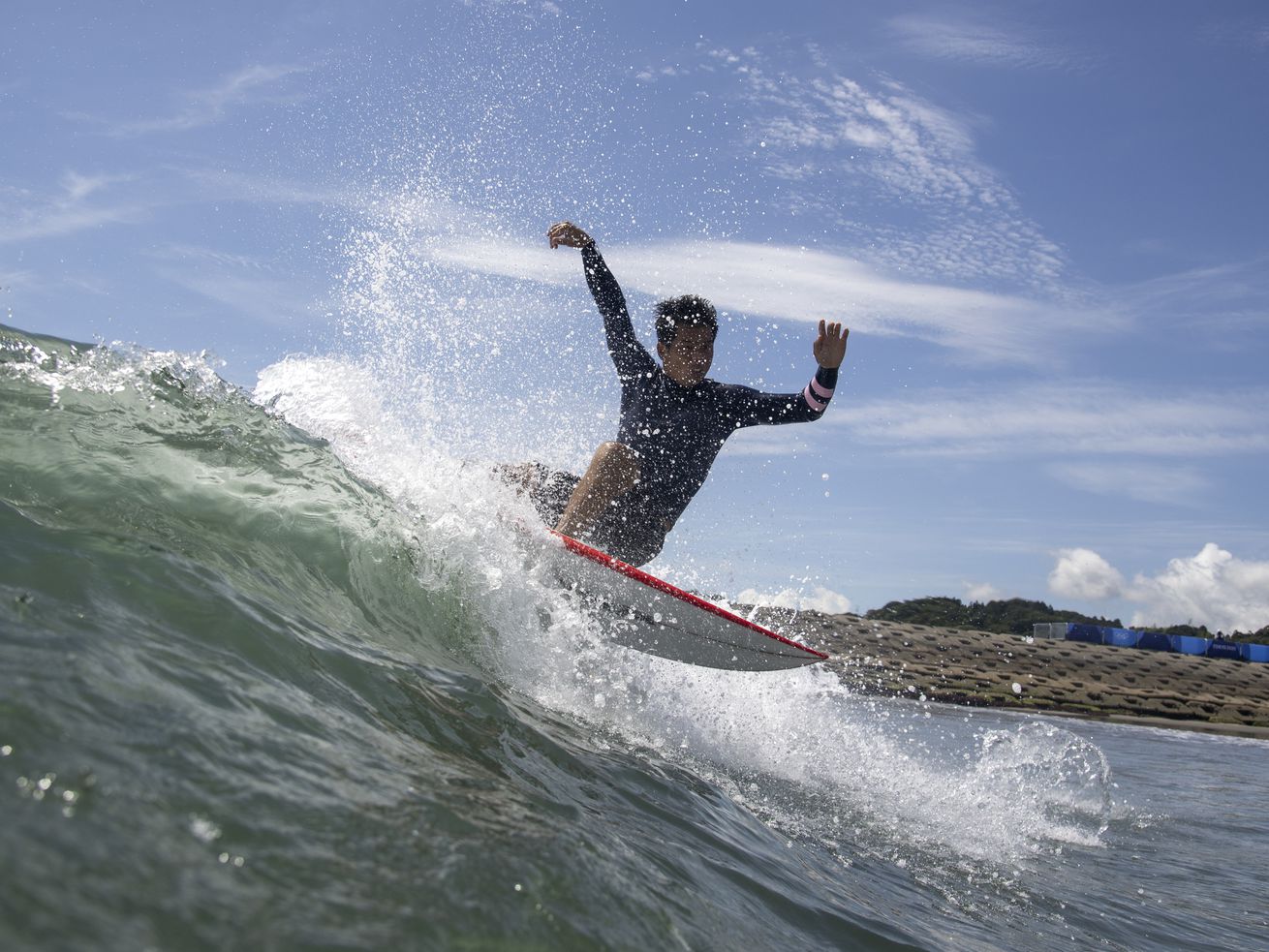Six new sports will be at the Tokyo Olympics — the most since 1920.
An amazing six new sports will be contested at the Tokyo Olympics. That’s the most new additions to an Olympics since 1920, when 11 sports entered the mix.
The “new” label Is a bit elastic. Two of the sports added to the Tokyo Games — the closely related baseball and softball — were featured at the Olympics as recently as 2008, before being dropped in 2012 and 2016. But the other four are complete newcomers: karate, skateboarding, sport climbing, and surfing. All six will join Olympic favorites like track and field, swimming, and gymnastics.
For the incoming sports, inclusion in the Olympics offers an important global spotlight — and crucially, the opportunity to grow.
“The Olympics are the highest, largest, most visible stage for any sport. Surfing being in the Olympic Games will be great for surfing. We’ll be allowed to communicate our message and our lifestyle to billions of people,” said Fernando Aguerre, president of the International Surfing Association. “It’s developing surfing, taking it to Africa, to Asia, to Latin America — to areas where there are incredible waves,” but there aren’t as many surfers.
There’s just one catch: These six new-for-Tokyo sports won’t all be part of the Paris Summer Games in 2024. Skateboarding, sport climbing, and surfing will be featured in 2024, with the surfing competition located in Tahiti, nearly 10,000 miles away from Paris. The Paris Games will also add breakdancing for the first time ever. But baseball, softball, and karate will be left out.
Yet come 2028 in Los Angeles, the Summer Games will likely re-expand to incorporate baseball and softball again. Whether breakdancing will survive to 2028 is anyone’s guess.
This endless shuffling of events all stems from an initiative designed to update and revamp the Olympics. Called “Agenda 2020,” the program was adopted by the International Olympic Committee (IOC) in 2014. It aims to give individual host cities more control over which events are medal sports. The goal, overall, is to make the Olympics less of a behemoth and an economic boondoggle.
Unfortunately, the shuffling also leads to uncertainty for a number of sports, which might be included for one Olympics and then cut from the next. The variety of events on offer will perhaps provide more adventurous choices for Olympics viewers who like watching sports they might not be able to see easily. (When was the last time you saw competitive karate broadcast in the US?) Yet, given how much stability and economic freedom is granted by a sport becoming a permanent part of the Olympics, that uncertainty can be devastating.
The divide between “core sports” and everything else at the Olympics
/cdn.vox-cdn.com/uploads/chorus_asset/file/22736305/593249436.jpg) Laurent Kalfala/AFP via Getty Images
Laurent Kalfala/AFP via Getty ImagesThe Summer Games will always feature a number of “core sports.” These sports have long histories within the Olympics, and they are so closely associated with the event that the Olympics would feel weird without, say, gymnastics or track and field or swimming.
An IOC working group suggested that the number of core sports be set at 25 in 2013, with weightlifting, wrestling, and modern pentathlon competing for slots 24 and 25 in that number.
At the time, the group initially recommended that wrestling be dropped from the program. It was seen as a sport prone to doping scandals, with ineffectual leadership failing to keep corruption in check. Yet just a few weeks later, the threat against wrestling petered out as the IOC’s full voting membership opted to keep the sport in the games. Wrestling has been part of the roster at every Olympics since and has yet to be dropped from the core sports program. In addition, golf and rugby sevens, first presented at Rio in 2016, have continued to make the cut for inclusion at subsequent Olympics. Thus, the Summer Games sure seem like they have 28 core sports, not 25. But the IOC keeps feinting toward bumping that number back to 25, presumably to keep everybody on their best behavior.
The threats against wrestling are a good example of how that IOC pressure works to externally police the sports federations that it recognizes.
“When wrestling was potentially going to be dropped from the Olympics, it was a huge shock. The wrestling federation [United World Wrestling, which oversees the sport at the games] got rid of its leadership and got new people in,” said Sydney Bauer, a freelance journalist who has covered the Olympics for nine years. “And the IOC had a vote at its [main] session, and then just put wrestling back in the core sports. So nothing changed. This was an excuse for the IOC to use its political pressure to change the Wrestling Federation.”
At any rate, if you’re a core sport, you’re theoretically always in the Olympics. (The IOC can change whatever it wants whenever it wants via a vote, but let’s assume for a second that that isn’t true.) What if you’re not a core sport, though? How do you get onto the program?
Before each Olympics, the organizing committee from each host city narrows down a list of proposals from IOC-recognized sports (more on this in a second) to a shortlist of events it thinks it has capacity to host. The host city then further narrows down that list to a bid that it submits to the IOC for approval. Tokyo initially considered nine sports — the six already mentioned (baseball, karate, skateboarding, softball, sport climbing, and surfing), plus squash, wushu, and roller sports — before narrowing that list to the six that will be featured in the Tokyo Games.
(Perhaps confusing matters: Baseball and softball have consolidated their organizing bodies into one group since the 2008 Olympics, so while the IOC counts baseball-softball as one sport, “the Tokyo Olympics considered eight sports for inclusion, including baseball-softball” doesn’t make a ton of sense, which is why I’m referring to the two as separate sports.)
By the way, pour one out for squash, a constant also-ran at the Olympics despite the sport having grown over decades so that it has a robust international presence. “Squash missed out again, which was a huge shock,” said Bauer. “They’ve been doing everything right but can’t get on the program.”
The Paris Olympics, meanwhile, opted not to include baseball, softball, or karate from their shortlist of seven sports, ending up with the four previously mentioned: breakdancing, skateboarding, sport climbing, and surfing.
There’s also a historical precedent of introducing new sports at the Olympics based on what’s popular locally. From 1912 to 1992, events called “demonstration sports” were included in the Olympics as an opportunity to allow audiences to check out sports popular in the cities hosting the Games. Sometimes, those sports even went on to become full Olympic sports. In 1984, for instance, Los Angeles presented demonstrations of baseball and tennis, both of which were later added as medal events at future Games.
The big difference between the current system and the demonstration sports system is that demonstration sports weren’t full medal events. Now, every sport that makes it into the games sends its victors home with shiny new hardware. If you win a baseball gold medal in the 2020 Olympics, you’re a gold medalist, even if baseball is never played at the Games again.
Want to be included in the Olympics? Being popular with the kids will sure help you out.
/cdn.vox-cdn.com/uploads/chorus_asset/file/22736308/1051945312.jpg) Fabian Ramella/picture alliance via Getty Images
Fabian Ramella/picture alliance via Getty ImagesBecoming an IOC-recognized sport is a long process crowded with bureaucracy, but in essence, it involves building out national, regional, and international organizations that can then be collected under the banner of “IOC-recognized sport.”
Essentially, lots of countries need to love your sport, which will give you an athlete base and an audience to hold regional events, which will then allow you to expand to international events, which will hopefully eventually land your event in the Olympics. The IOC has a list of criteria it checks off for inclusion, but those criteria are somewhat nebulous, as you can see discussed here by the international federation governing the sport of muaythai, which was granted provisional recognition by the IOC just this year.
There’s also a lot of glad-handing and politicking involved in this process. Building the right connections within the IOC is a must, as is navigating many other sports federations and competitions.
Yet you likely have a leg up once you’re a recognized sport if you either appeal to young people or to the citizens of the country hosting that current Olympic Games.
In particular, there’s been a pronounced focus in the events that have been added recently on finding sports that will appeal to “the youths.” The IOC has increasingly used the Youth Olympics, a perpetually beleaguered event for athletes between 14 and 18 years old, as a way to try out events that might merit Olympic inclusion. Breakdancing, for instance, will make its Olympics debut in 2024 after a successful trial run at the 2018 Youth Olympics in Buenos Aires. (The Youth Olympics are held every four years but on an alternating schedule, so the Winter Youth Olympics happen in years when there is a Summer Olympics and vice versa.)
The use of the Youth Olympics to try out new sports is a hallmark, Bauer said, of the IOC under current president Thomas Bach, who took office in 2013.
“It’s an ethos of, ‘Okay, we need to appeal to young people. We need young millennials and Gen Z to be interested in the Olympics, and they don’t care about wrestling. They don’t care about weightlifting. They don’t care about track and field. So how can we get young people interested, but also not change everything we’ve done with these core sports because they’re very old Federations and make a lot of money?’” she said.
Bach has kicked off numerous efforts to streamline the Games and make them more flexible. Even with four sports added to the 2024 Games, for instance, the overall number of events will decline from 339 to 329, with most of the cuts coming from the boxing and weightlifting programs.
What’s more, the IOC’s efforts to include events that will allow for full parity between men’s and women’s events have improved considerably under Bach. The number of women competing in Tokyo should be 48.8 percent of the total number of competing athletes, and the 2024 Games hope to hit 50 percent on the dot. That’s well up from 38.2 percent at the 2000 Olympics in Sydney.
The flexibility developed under Bach also allows individual sports to be tried out one Olympics at a time. If they prove wildly popular, they might be added in future Games — especially if they’re sports that don’t require building expensive facilities. (Surfing, for example, mostly just requires having an ocean.)
This approach also allows recognized sports an opportunity to compete to be included in Games hosted by countries where they are popular. Baseball, softball, surfing, and skateboarding seem like cinches to be added to the Los Angeles Games in 2028 because all four sports are wildly popular in the US and in California more specifically. (Aguerre points out that California is the home of surfing and skateboarding culture worldwide.)
Any sport that is popular in America (and some sports that are not but that are growing more popular around the world) might bid as well. Already, cricket (which is not super popular in the US but is growing in stature, especially in areas with large South Asian immigrant populations) and flag football(!!) are vying to be added to the 2028 Games. Other sports with a footprint in the US, such as ultimate Frisbee (known as “world flying disc” internationally) might have a shot as well, should they vie for inclusion.
Finally, these more recent reforms allow for shifts in the longtime stranglehold that events popular in Europe have had on the Olympics. Baseball fought for years and years to be included, and its struggles have been widely attributed to the fact that while the sport is incredibly popular in East Asia and the Americas, it’s not popular at all in Western Europe.
The case against baseball in the Olympics is slightly more nuanced than “people in Europe don’t like it.” Baseball is a sport played only by men, and its previous Olympics inclusions were not commercially successful. The consolidation of baseball and softball into one federation took care of the first problem; a successful event in Tokyo could take care of the second. Baseball is also making great strides internationally, with federations spinning up all over the globe in places like South Africa, Israel, and Brazil.
Still, the pro-Europe bias at the Olympics was real — and the IOC is taking steps to combat that problem too.
“The IOC has been on a big blitz to make its membership not just be Western European,” Bauer said. “The IOC is huge now. It’s up to around 105 members. There’s an IOC member now from Afghanistan. There’s one from Bhutan. There’s one from Palau. These are countries that are represented now because they’re trying to create geographic diversity, where in the past, if you weren’t from Western Europe, you were being held back because [the IOC is] based in Switzerland.”
In the end, even if your sport is selected for the Olympics, there’s no guarantee your event will be a success. That lies with forces beyond anyone’s control. But Aguerre, the ISA president, has high hopes for surfing in Tokyo.
“The biggest thing that made me so happy was realizing that there are going to be waves [in Tokyo], plenty of waves,” he said, citing local forecasts. “The only uncertainty is: Are there going to be waves? And we’re gonna have a week of waves. It’s nice.”
Author: Emily VanDerWerff
Read More



